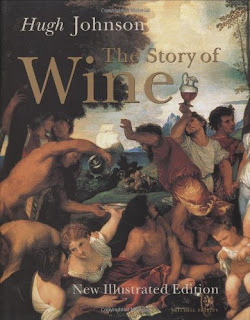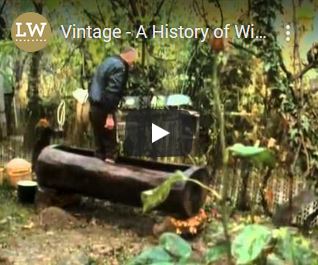The Story of Wine - by Hugh Johnson
Written by the world’s bestselling wine author, this illustrated edition is an enthralling read, tracing the story of wine from the dawn of civilization and includes modern developments in wine. The book is no longer in print but you can find copies online.
Written by the world’s bestselling wine author, this illustrated edition is an enthralling read, tracing the story of wine from the dawn of civilization and includes modern developments in wine. The book is no longer in print but you can find copies online.
This book was accompanied by a 13 part BBC documentary series Vintage - A History of Wine and was broadcast in the US on PBS in 1989. The series was also available in a boxed set on VHS tape.
Short edited episodes of the original TV documentary are available for viewing on YouTube:
Basic Home Wine Making - Fermentation
Yeast is a single celled fungus that feeds on sugars, vitamins, minerals, and water producing roughly equal parts by weight of carbon dioxide and alcohol. We call this conversion Alcoholic Fermentation. Wine is an alcoholic beverage produced when yeast converts the natural sugars found in fruit juice into alcohol and the carbon dioxide gas is expelled. Only one fruit - Vitis vinifera - wine grapes contain everything needed, when ripe, to produce a wine that is strong
enough to be stable and won't quickly go sour and spoil. No other grape variety or fruit contain enough
natural sugars to produce a stable wine. Natural wild yeasts are found
everywhere, especially on the outside skins of of fruit, so by simply
crushing wine grapes and allowing the wild yeast to mix with the juice, you will
produce wine. This is how it all began. Other fruits and juices can be
used to make wine at home, but sugar must be added to produce enough alcohol to make a stable wine. A stable wine should contain at least 8% alcohol or higher. At this level the antiseptic property of alcohol will inhibit the growth of spoilage organisms and the wine is stable. Below this level wine is very susceptible to
mold and bacteria. Wild or weak yeasts may struggle to produce a stable wine. Alcohol levels much higher than 15% will not only
prevent the growth of unwanted bacteria but will inhibit most wine yeast as
well. Some special wine yeast may reach up to 18% alcohol, yet too much sugar can cause fermentation to slow or become stuck and eventually too much sugar will prevent complete fermentation.
Unfortunately many other organisms, along with the wild yeasts, occur everywhere and some of these organisms can spoil wine. Acetobacter is a very common bacteria that will turn good wine into bad vinegar. Modern wine-making does not rely on dirty wild yeast
to produce wine. Purified yeast strains have been developed for
specific wine making requirements. Other techniques are used to prevent
unwanted organisms from contaminating the wine.
Home
wine makers can benefit from using purified wine yeasts and by
preventing spoilage organisms from reaching the wine. Purified wine yeasts are not the same as the yeast used for making bread. Good wine yeasts are cheap and easy to find at any wine-making or homebrewing shop or online. Keeping all
equipment and containers clean and sanitary is the most important rule
for making good wine. Using a closed fermentation system is another
technique for making good wine at home. Closed fermentation simply means
using a closed container that blocks both oxygen and any unwanted bacteria from contaminating the wine. During the fermentation process
yeast converts sugars into alcohol and carbon dioxide gas. It is
necessary to have some way to vent off this excess CO2 gas otherwise
pressure can build up inside a closed container forcing it to overflow
making a big mess and may even rupture the container. Bacteria requires oxygen to grow and spoil your wine. Yeast is anaerobic meaning it does not use oxygen during Alcoholic Fermentation. This anaerobic process is the reason for using a closed fermenter with one-way valve or airlock. These airlocks are commonly
available at any wine-making supply shop or online. They work
by allowing the excess CO2 gas to "bubble" out through a one-way liquid trap
while blocking air from entering your closed fermentation container.
White wines are typically made by fermenting white grape juice that is
pressed and strained from crushed grapes while red wines are made
by fermenting crushed red grape pulp for several days before pressing
out the juice. This is done to extract the red pigment and tannins and flavors which are
contained in the grape skins and seeds. Home winemakers can use many different
fruits and juices for making wine. Home grown fruit or berry wines are usually
made in the same manner as red grape wine and the wine starts with
crushed fruit pulp and after several days of fermentation the pulp is strained off
and the juice pressed out. Either way the early fermentation period is usually very active - foaming and
churning away inside the container. In a week or two this active fermentation
period will slow down considerably as most of the sugars are consumed and converted into alcohol.
A bucket or plastic barrel is needed when working with crushed fruit pulp. Just remember not
to
fill your container too full. Four to six inches of air space or more is needed
to be safe - otherwise the excess foam that is produced during the early active fermentation can overflow your container and will make a big
mess. It is also important to stir the fruit pulp every day during the active fermentation. The pulp will float on top and needs to be mixed or "punched down" daily to ensure good color and flavor extraction. A large
glass jug called a carboy makes an excellent closed fermentation system to make wine
from fruit juice. You can attach a large plastic tube called a blow-off hose to the glass carboy as
illustrated above to create a giant airlock. This is my method when
working
with all juice and no pulp. The extra air space is fine. Carbon dioxide gas is heaver than oxygen. During the very active primary fermentation as CO2 is generated it will will force the air out of your fermenter and act as an oxygen barrier preventing bacteria growth. You can simply cover your bucket or barrel with a plastic sheet to keep dirt and fruit flies out. I use a giant rubber band to keep the plastic sheet in place and that allows the gas to escape around the edge.
After
the primary active fermentation slows down you should siphon the new wine to
another secondary closed container to finish fermentation and to settle out the dead yeast.
Be careful when you siphon the new wine to leave behind as much of the
sludge as you can.
You can watch the wine clearing through the glass and it
will be ready to bottle when all fermentation is finished and the wine is clear. Wine improves with time and can take several months to settle and become clear. Racking or transferring the clear wine to a clean container leaving behind any dead yeast sediment every 2-3 months will improve your wine. You want to keep your carboys filled almost to the top. Oxygen is not good for wine, besides allowing bacteria to grow it can cause oxidized stale flavors and cause some wines to lose color or turn brown. You can add a little water or some
finished wine to top up the jug. Always use an airlock to keep oxygen and
bacteria from getting into your wine.
Serious home winemakers will have many different sized containers, both glass carboys and jugs and plastic buckets or barrels, for making wines.
Winemaking – Flow of Chemistry and Art
As I was surfing the web I found a blog that put into words my very feelings much better that I could have. The blog is no longer available and the author did not publish their name - but it is worth reading here again as it was first published on February 14, 2011 on their blog called Philosophically Disturbed:This morning I had the fortunate opportunity to chat with Matthew Pellew, Senior Red Winemaker of Grant Burge Wines in Tanunda. I rolled up just after 11:00AM and even before I walked into the sales room, I detected a warm smell of currants, chocolate and berries in the air, a fragrance synonymous with the red wines I heavily favour. Then again some may argue that this is the fragrance of the Barossa Valley.
As I walked around the Grant Burge at Illaparra, I could not help but see the striking similarities between the industrial set up of the winemaking facilities and some minesites I have worked at. There was just something about the large tanks and hoses with the occasional forklift motoring away in a shed. Only instead of metal ore extracted, wine was being created. It seemed like miniaturised versions of tanks on a minesite.
The sheer amount of chemistry that needs to be considered in the creation of wine is astounding and it is difficult to tell from where it begins. It is also incredibly complex.
When it comes to yeast, in red wines about 5 different strains of yeast are used. In white wines there up to 12 different strains of yeast used. And sometimes there is the need to add different strains of yeast at different times in the fermentation stage to bring out the full flavours of the wine.
A winemaker not only needs to be familiar with vineyards and grape species but also with the wood that the barrels are made from. Although a barrel may be watertight, the wine penetrates 2-3mm into the wood of the barrel it sits in to age. This is where it comes in contact with the air that has travelled through the pores of the wood and oxidises. The wine is monitored and tasted at crucial stages. Too much oxidation and the wine could turn into vinegar which doesn’t make for good drinking.
Conversely there can be a reason to add oxygen to wine. Micro-oxygenation was developed by Patrick Ducournau and Thierry Lemaire of the French company Oenodev. It has come after much work and research into the role of oxygen in the many microbiological and biochemical reactions that take place during the life of a wine. Some of these can be beneficial to the winemaking process as well as define the characteristic of the finished product.
Micro-oxygenations is a controlled process of introducing very small measured amounts in a controlled manner to the wine manipulating the ageing process for a number of reasons including the stabilisation colour and intensity and improving the taste.
This was just some of the things that Matthew Pellew spoke to me about. It was fascinating but what really came through today as well as the scientist was the artist within him. There are some things that he trusts his instinct and 20 years of experience to when blending wine.
“It’s what I know. Winemaking is a balance between the chemistry and just knowing that things come together.”







No comments:
Post a Comment